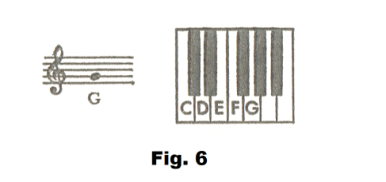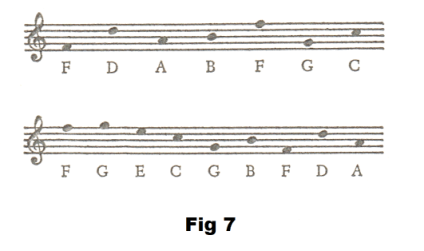
Website owner: James Miller
Music, Piano keyboard, Octave, Pitch class, Major diatonic scale, Major chord, Chromatic scale, Tempered scale, Staff, Clef.

Piano keyboard. The standard piano keyboard contains 88 keys consisting of a repeated pattern of seven white keys labeled C, D, E, F, G, A, B, and five black keys. See Figures 1 and 2.

Middle C. A keyboard with 88 keys has a total of eight C's; middle C is the fourth C from the left. The very first note on an 88-key keyboard is an A. See Fig. 1.
Tone. A sound having a definite pitch (or number of vibrations per second).
Fundamental tone. The tone which is produced by an object that is vibrating as a whole.
Overtone. A tone whose vibration rate is a whole number multiple of that of the fundamental.
Quality. A property of sound waves which depends on the number and prominence of the overtones.
Octave. Music 1. The eighth full musical tone above a given tone, having twice as many vibrations per second, or below a given tone, having half as many vibrations per second. 2. The interval between one tone and another tone having twice as many or half as many vibrations per second.
Example. If one note has a frequency of 440 Hz, the note one octave above is at 880 Hz, and the note one octave below is at 220 Hz.
In music notation, notes separated by an octave (or multiple octaves) have the same letter name and are of the same pitch class.
Pitch class. In music, a pitch class (p.c. or pc) is a set of all pitches that are a whole number of octaves apart, e.g., the pitch class C consists of the Cs in all octaves.
Major diatonic scale. Construction. We shall now discuss the construction of a musical scale called the major diatonic scale. To set the frequencies of the various piano keys for the major diatonic scale one first tunes the middle C key to a specified frequency. Here we will use 256 cycles per second as the frequency of middle C (the frequency used by physicists). Then we use middle C as the first note and the frequencies of notes D, E, F, G, A, B are obtained by multiplying the middle C frequency of 256 by the vibration ratios 9/8, 5/4, 4/3, 3/2, 5/3, 15/8, and 2 (shown in the bottom line of Fig. 3), i.e.
D is tuned to 9/8×256 = 288 cycles per second.
E is tuned to 5/4×256 = 320 cycles per second.

F is tuned to 4/3×256 = 341 cycles per second.
G is tuned to 3/2×256 = 384 cycles per second.
A is tuned to 5/3×256 = 426 cycles per second.
B is tuned to 15/8×256 = 480 cycles per second.
Cʹ is tuned to 2×256 = 512 cycles per second.
The vibration rates of Dʹ, Eʹ, etc. are then computed using the same vibration ratios but multiplying by the Cʹ frequency of 512.
Def. Major chord. The combination of tones produced by sounds whose frequencies are in the ratio 4, 5, and 6.
In the major diatonic scale there are three major chords:
1. notes C, E, G;
2. notes G, B, Dʹ
3. notes F, A, Cʹ
The diatonic scale devised above was so devised, through use of the given vibration ratios, as to have these three major chords.
Def. Diatonic scale. A musical scale built up from three major chords.
Def. Chromatic scale. The diatonic scale with five half tones added.

Chromatic scale. Construction. Let us construct a scale using D, with a frequency of 288, as the first note. To find the frequencies of the notes in this scale, we multiply 288 in turn by 9/8, 5/4, 4/3, 3/2, 5/3, 15/8, and 2 obtaining the values shown in the second line of Fig. 4. Comparing the numbers in the two lines in Fig. 4 for the Key of C and the Key of D we note that many of the numbers are the same or are quite close. However, in the cases of F and Cʹ there is a considerable difference. This difference is so great that two new notes, F# (F sharp) and C# (C sharp) are used by a musician when he plays in the key of D.
How does the frequency of the new note F# compare with that of F? The ratio 360/341 is approximately equal to 25/24. The frequency rate of F# is thus about 25/24 that of F. F# is said to be a half tone higher than F. If a note in the chromatic scale is to be lowered a half tone or flatted, the frequency of the flatted tone is 24/25 of the original tone.
Suppose now that we build up a series of scales using each of the notes in the Key of C scale as the first note. If we did this we would find that five new notes would need to be added to each octave to take care of serious variations in frequency between the scales. The chromatic scale is the diatonic scale with five half tones added.
Def. Tempered scale. A twelve-note scale with a constant frequency change between successive notes.

The Tempered scale. The scale commonly used for tuning and playing musical instruments is a compromise scale in which there is a constant change of frequency between successive notes. There are twelve intervals between successive notes, and since the frequency of Cʹ must be twice that of C, the ratios between the frequencies of successive notes is made equal to the twelfth root of 2
![]()
This means that the frequency of any note in the tempered scale can be obtained by multiplying the frequency of the preceding note by 1.05946.
The notes and their frequencies in both the Chromatic and Tempered scales are shown in Fig. 5. Note that in the Chromatic scale C# has a frequency of 266.6 and Db (D flat) has a frequency of 276.5 while in the Tempered scale both are set to the same compromise value of 271.2. Looking down through the list one will see that the same thing is done with D# and Eb, F# and Gb, G# and Ab, etc.
This tempered scale is used in playing most musical instruments.
The pitch used by musicians differs from that used by physicists. We used the middle C pitch of 256 cycles per second for the discussion above, which is the pitch used by physicists. When middle C has a frequency of 256, the frequency of A above middle C has a pitch of 427. The American Federation of Musicians has adopted 440 cycles per second as the frequency of A above middle C. The pitch used by musicians for middle C is based on this 440 cycles per second frequency for A.
Def. Staff. A set of five horizontal lines used in representing music. See the left figure in Fig. 6. The five lines plus the spaces between them represent nine successive ascending pitches beginning at the bottom line and going up.
Def. Clef. A musical clef is a sign that is placed at the left-hand end of a staff, informing the reader of the pitch of the second line from the bottom of the staff. In Fig. 6 the fancy figure at the left end of the staff represents the letter G. It is only one of several clef signs that are used, but the most important one. It is called the treble clef or G-clef. This sign informs the reader that the second line from the bottom of the staff represents the G note following middle-C. In this way the note values of the other lines and the spaces between them is established. For example the third line up corresponds to the B note, the fourth line up corresponds to the D note, the top line corresponds to the F note, the space between the second and third line corresponds to the A note, the space between the third and fourth line corresponds to the C note, etc. Figures 7 and 3 show representations of various notes. In Fig. 3 notice that notes can be represented below the bottom line.

References
Dull, Metcalfe, Brooks. Modern Physics

Jesus Christ and His Teachings
Way of enlightenment, wisdom, and understanding
America, a corrupt, depraved, shameless country
On integrity and the lack of it
The test of a person's Christianity is what he is
Ninety five percent of the problems that most people have come from personal foolishness
Liberalism, socialism and the modern welfare state
The desire to harm, a motivation for conduct
On Self-sufficient Country Living, Homesteading
Topically Arranged Proverbs, Precepts, Quotations. Common Sayings. Poor Richard's Almanac.
Theory on the Formation of Character
People are like radio tuners --- they pick out and listen to one wavelength and ignore the rest
Cause of Character Traits --- According to Aristotle
We are what we eat --- living under the discipline of a diet
Avoiding problems and trouble in life
Role of habit in formation of character
Personal attributes of the true Christian
What determines a person's character?
Love of God and love of virtue are closely united
Intellectual disparities among people and the power in good habits
Tools of Satan. Tactics and Tricks used by the Devil.
The Natural Way -- The Unnatural Way
Wisdom, Reason and Virtue are closely related
Knowledge is one thing, wisdom is another
My views on Christianity in America
The most important thing in life is understanding
We are all examples --- for good or for bad
Television --- spiritual poison
The Prime Mover that decides "What We Are"
Where do our outlooks, attitudes and values come from?
Sin is serious business. The punishment for it is real. Hell is real.
Self-imposed discipline and regimentation
Achieving happiness in life --- a matter of the right strategies
Self-control, self-restraint, self-discipline basic to so much in life